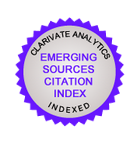РЕГУЛЯЦИЯ ПРОЛИФЕРАТИВНОЙ АКТИВНОСТИ И ХИМИОРЕЗИСТЕНТНОСТИ ОПУХОЛЕВЫХ КЛЕТОК АСКОРБАТОМ НАТРИЯ
https://doi.org/10.29235/1561-8323-2018-62-1-93-100
Аннотация
Исследовано влияние аскорбата в физиологических концентрациях на пролиферативную активность и химиорезистентность клеток карциномы гортани человека линии НЕр-2. Установлено, что при действии аскорбата в концентрации 60 мкМ скорость пролиферации опухолевых клеток увеличивается в 1,5 раза. Аскорбат вызывает изменение функционального состояния опухолевых клеток, в результате которого увеличивается их резистентность к доксорубицину и тимохинону. Показано, что ингибитор НАДФН-оксидазы апоцинин блокирует стимулирующий эффект антиоксиданта. Полученные результаты свидетельствуют об участии активных форм кислорода, продуцируемых НАДФН-оксидазой, в механизме активации адаптационного ответа клеток, индуцированного аскорбатом.
Ключевые слова
Об авторах
Г. Г. МартиновичБеларусь
д-р биол. наук, доцент, заведующий кафедрой
пр. Независимости, 4, 220030, Минск
И. В. Мартинович
Беларусь
ст. науч. сотрудник
пр. Независимости, 4, 220030, Минск
А. В. Вчерашняя
Беларусь
мл. науч. сотрудник
пр. Независимости, 4, 220030, Минск
Н. К. Зенков
Россия
д-р биол. наук, вед. науч. сотрудник
ул. Академика Тимакова, 2, 630117, Новосибирск
Е. Б. Меньщикова
Россия
д-р мед. наук, доцент, гл. науч. сотрудник
ул. Академика Тимакова, 2, 630117, Новосибирск
С. Н. Черенкевич
Беларусь
академик, д-р биол. наук, профессор
пр. Независимости, 4, 220030, Минск
Список литературы
1. Du, J. Ascorbic acid: Chemistry, biology and the treatment of cancer / J. Du, J. J. Cullen, G. R. Buettner // Biochim. Biophys. Acta. – 2012. – Vol. 1826, N 2. – P. 443–457. doi.org/10.1016/j.bbcan.2012.06.003
2. Cameron, E. Supplemental ascorbate in the supportive treatment of cancer: prolongation of survival times in terminal human cancer / E. Cameron, L. Pauling // Proc. Natl. Acad. Sci. USA. – 1976. – Vol. 73, N 10. – P. 3685–3689. doi.org/10.1073/ pnas.73.10.3685
3. High-dose vitamin C versus placebo in the treatment of patients with advanced cancer who have had no prior chemotherapy A randomized double-blind comparison / C. G. Moertel [et al.] // N. Engl. J. Med. – 1985. – Vol. 312, N 3. – P. 137–141. doi.org/10.1056/nejm198501173120301
4. Vitamin C pharmacokinetics: implications for oral and intravenous use / S. J. Padayatty [et al.] // Ann. Intern. Med. – 2004. – Vol. 140, N 7. – P. 533–537. doi.org/10.7326/0003-4819-140-7-200404060-00010
5. Pharmacologic doses of ascorbate act as a prooxidant and decrease growth of aggressive tumor xenografts in mice / Q. Chen [et al.] // Proc. Natl. Acad. Sci. USA. – 2008. – Vol. 105, N 32. – P. 11105–11109. doi.org/10.1073/pnas.0804226105
6. Pharmacological ascorbic acid suppresses syngeneic tumor growth and metastases in hormone-refractory prostate cancer / H. B. Pollard [et al.] // In Vivo. – 2010. – Vol. 24. – P. 249–255.
7. Suh, J. Ascorbate does not act as a pro-oxidant towards lipids and proteins in human plasma exposed to redox-active transition metal ions and hydrogen peroxide / J. Suh, B. Zhu, B. Frei // Free Radic. Biol. Med. – 2003. – Vol. 34, N 10. – P. 1306–1314. doi.org/10.1016/s0891-5849(03)00147-3
8. Редокс-регуляция клеточной активности: концепции и механизмы / С. Н. Черенкевич [и др.] // Весці НАН Беларусі. Сер. біял. навук. – 2013. – № 1. – C. 92–108.
9. Martinovich, G. G. Effects of ascorbic acid on calcium signaling in tumor cells / G. G. Martinovich, I. V. Martinovich, S. N. Cherenkevich // Bull. Exp. Biol. Med. – 2009. – Vol. 147, N 4. – P. 469–472. doi.org/10.1007/s10517-009-0555-6
10. Redox regulation of calcium signaling in cancer cells by ascorbic acid involving the mitochondrial electron transport chain / G. G. Martinovich [et al.] // Journal of Biophysics. – 2012. – Vol. 2012. – Art. 921653. doi.org/10.1155/2012/921653
11. Martinovich, G. G. Redox regulation of cellular processes: a biophysical model and experiment / G. G. Martinovich, I. V. Martinovich, S. N. Cherenkevich // Biophysics. – 2011. – Vol. 56, N 3. – P. 444–451. doi.org/10.1134/s0006350911030171
12. Phenolic antioxidant TS-13 regulating ARE-driven genes induces tumor cell death by a mitochondria-dependent pathway / G. G. Martinovich [et al.] // Biophysics. – 2015. – Vol. 60, N 1. – P. 94–100. doi.org/10.1134/s0006350915010194
13. Thymoquinone, a biologically active component of Nigella sativa, induces mitochondrial production of reactive oxygen species and programmed death of tumor cells / G. G. Martinovich [et al.] // Biophysics. – 2016. – Vol. 61, N 6. – P. 963–970. doi.org/10.1134/s0006350916060154
14. Mazes of Nrf2 Regulation / N. K. Zenkov [et al.] // Biochemistry (Mosc). – 2017. – Vol. 82, N 5. – Р. 556–564. doi. org/10.1134/s0006297917050030
15. Dinkova-Kostova, A. T. Chemical structures of inducers of nicotinamide quinine oxidoreductase 1 (NQO1) / A. T. Dinkova-Kostova, J. W. Fahey, P. Talalay // Meth. Enzymol. – 2004. – Vol. 382. – P. 423–448. doi.org/10.1016/s0076-6879(04)82023-8
16. Ascorbic acid reduces HMGB1 secretion in lipopolysaccharide-activated RAW 264.7 cells and improves survival rate in septic mice by activation of Nrf2/HO-1 signals / S. R. Kim [et al.] // Biochemical Pharmacology. – 2015. – Vol. 95, N 4. – P. 279–289. doi.org/10.1016/j.bcp.2015.04.007
17. NADPH oxidase activity is required for endothelial cell proliferation and migration / M. Abid [et al.] // FEBS Letters. – 2000. – Vol. 486, N 3. – P. 252–256. doi.org/10.1016/s0014-5793(00)02305-x













































